#heteromorph
Text
Nipponites mirabilis from the upper cretaceous with speculative chromatophores and UV fluorescence
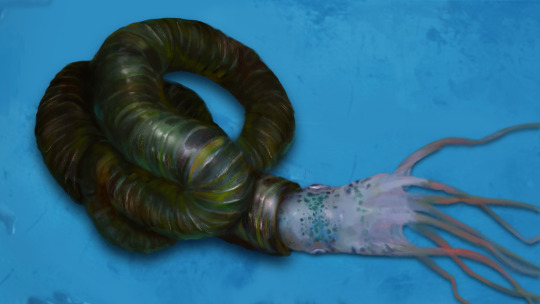
#art#digital art#illustration#paleoart#paleo art#paleontology#illustrationdigital#mollusks#cephalopod#ammonites#ammonite#cretaceous#nipponites#nipponites mirabilis#heteromorph#2d animation#digital animation#paleoanimation#palaeoblr
361 notes
·
View notes
Text
WORDPLAY WEDNESDAY...and YESTERDAY'S TRIVIA ANSWERED
Happy Windsday everybody (it's pretty darn windy in eastern Oregon right now lol)
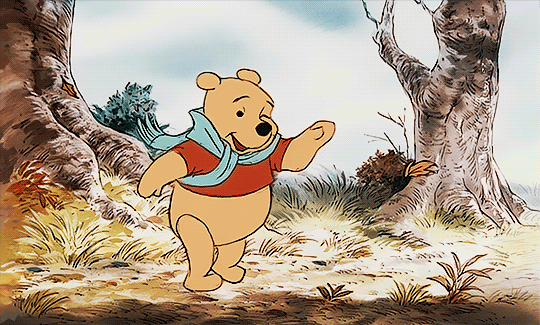
All right, down to business. First, let's answer yesterday's trivia: when did ammonites first evolve?

The middle Devonian Period around 410-385 million years ago!
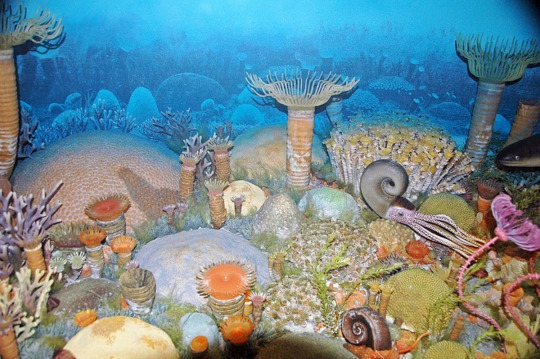
Second, time to learn a new word! And that word is HETEROMORPH. This is a word I have used a bunch this month but what does it mean? Let's beak it down:
hetero-different
morph-to gradually change
therefore, heteromorph means to gradually change to something different. Our ammonites started with coiled shells with some gradually unfurling or curling in a different manner.
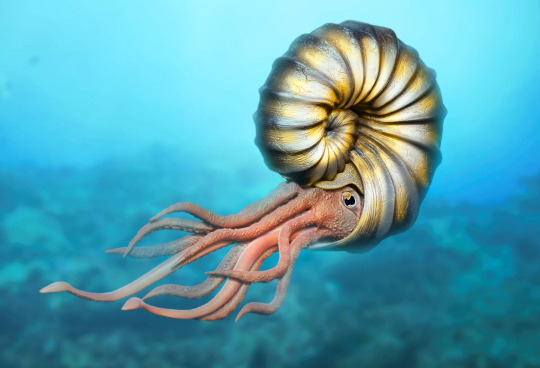


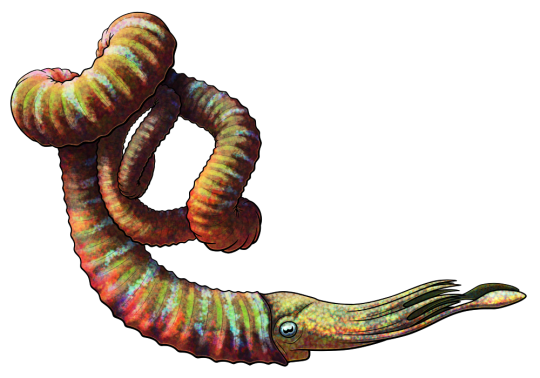

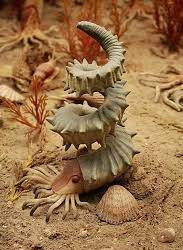
Isn't linguistics cool?
9 notes
·
View notes
Text
*bouncing up and down in excitement*
OK. The BNHA manga is talking about heteromorphs. Good. Good. Lots of Shoji content. Wonderful. OK.
BUT DOES THAT ALSO MEAN MAYBE AN OJIRO FOCUS CHAPTER OR AT LEAST MORE PANELS OF HIM PLEASE IF NOT BACKSTORY?
Surely talking about mutation quirks includes him, even if it’s only his taaaaaail.
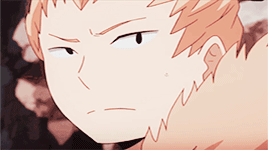
#sarah rambles#bnha spoilers#manga spoilers#ojiro#mashirao#shoji#mezo#heteromorph#mutation quirk#ojiro mashirao
5 notes
·
View notes
Text
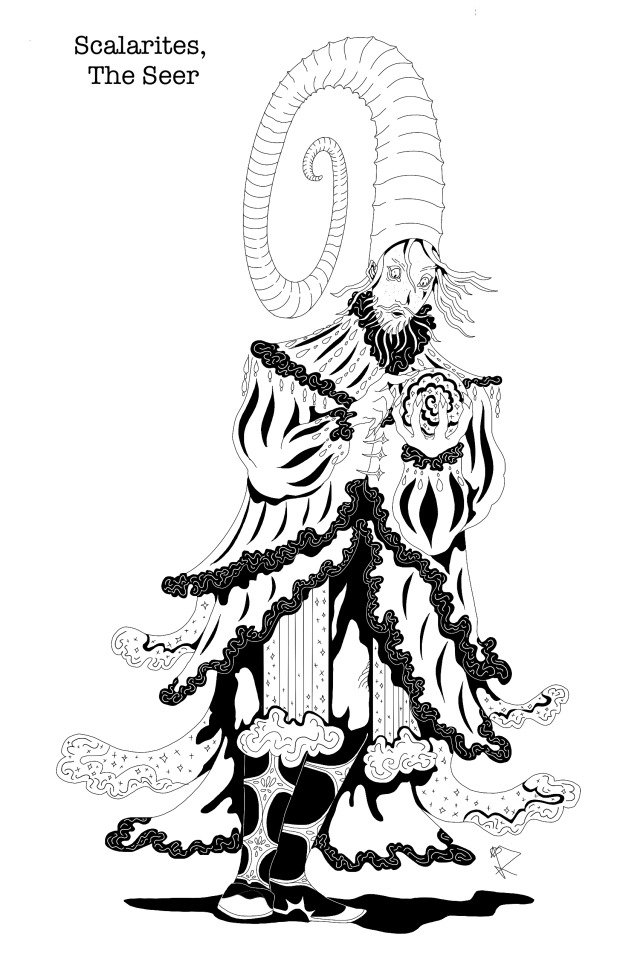




Heteromorph Ammonite shells always look like wizard hats to me, and so here are a few varieties depicted as anthropomorphic wizards. Once I have a reliable printing set up I hope to compile these, along with seven other wizard designs, into a zine.
#anthropomorphic#anthro#wizard#wizard art#ammonite#heteromorph ammonite#paleoart#hello everyone in the paleoart tags looking for realistic paleoart. Look at my fucking wizards.#Anyways printing my beloathed printing is the number 1 hurtle keeping me from producing art#accessible art#id in alt#alt text
1K notes
·
View notes
Text
Jeanist: I can excuse your heteromorphobia, but I draw the line at pleather.
Hawks: You can excuse heteromorphobia?!?!
Mirko: Yeah, can we walk that back for a minute?!?!
#me: what is bias against heteromorphs called???#me: oh I know#mha memes#mha incorrect quotes#boku no hero academia#mha#hawks#best jeanist#bnha#Mirko
77 notes
·
View notes
Text
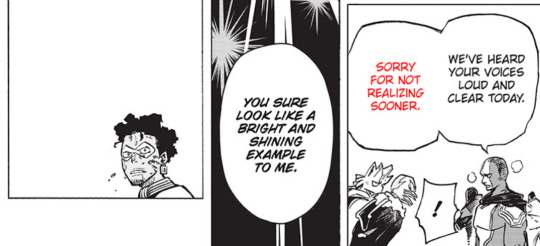

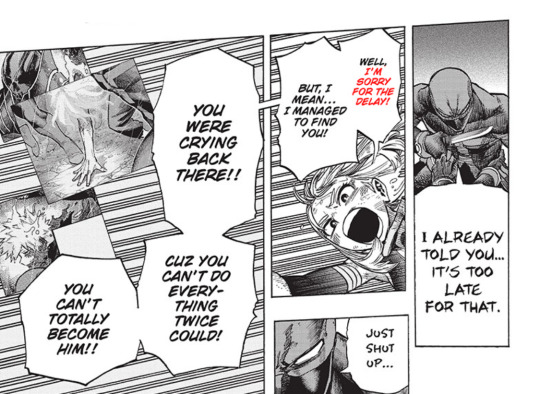
Now to wait for Deku's apology to Shigaraki
#Rando Hero Apologizing To Heteromorphs#<- lmao#Dabi#Todoroki Touya#Endeavor#Todoroki Enji#Toga Himiko#Uraraka Ochako#shigaraki tomura#bnha#mha#heroaca#Chapter 373#Chapter 390#Chapter 391#nalslastworkingbraincell
71 notes
·
View notes
Text
It's interesting that out of all of Class 1A's "big three", Izuku is the only one who chose someone who was clearly a heteromorph for his team.
And as an aside it's absolutely bizarre that Tokoyami didn't get picked by other teams. He had a decent number of points from the first round and 1A at least knew he was strong.
Not sure what was going on with that: mutant discrimination, the first round not playing to his strengths at the time, or just Tokoyami being a weird little man who hangs out in the corner reciting grimdark prose
#bnha reread#bnha chapter 27#bnha#midoriya izuku#tokoyami fumikage#yes i realize it's debatable whether mina qualifies as a heteromorph#but recent arcs seem to focus heteromorph discrimination based on whether the person has a “human face”#and mina's face is largely normal outside of her coloration#hero society seems biased towards flashy emitter quirks with human faces#and mina is kind of in the ballpark of passing this expectation of the flashy emitter quirk with a human face
80 notes
·
View notes
Text

Strange Symmetries #16: Go Home Heteromorphs You're Drunk
Most ammonites had spiral-coiling shells, but during the Cretaceous a group known as the heteromorphs evolved a much weirder range of forms. Some were straightened, some were hooked, some had helical snail-like shapes, and some even ended up bearing a strange resemblance to paperclips.
But one of the most bizarre of all was the genus Nipponites, whose ribbed shell looked like a bundle of tangled asymmetrical coils.
Nipponites bacchus lived in what is now Hokkaido, Japan, during the late Cretaceous about 90 million years ago. Around 10cm long (~4"), its shell was less tightly coiled up than its better-known relative Nipponites mirabilis, but these looser whorls were formed in the same way via a series of U-bends in different directions during its growth.
Despite their irregular and ungainly appearance, the unique shape of these ammonites seems to have actually been very hydrodynamically stable. They weren't fast-moving, but they didn't need to be, probably spending most of their time floating suspended in the water column catching small planktonic prey from around themselves.
———
NixIllustration.com | Tumblr | Twitter | Patreon
#science illustration#strange symmetries#paleontology#paleoart#palaeoblr#nipponites#nostoceratidae#ancyloceratina#heteromorph ammonite#ammonite#cephalopod#mollusc#invertebrate#art#go home evolution you're drunk
365 notes
·
View notes
Text
On Heteromorphs and Heteromorphobia (Arc XV - My Villain Academia)
(Skewing away from the wiki arc titles here, because come the eff on; everyone on god's green earth calls this My Villain Academia, not "The Meta Liberation Army Arc.")
At the request of a kind asker, I'm trying something different with footnotes this time; you'll find them at the end of the relevant bullet point, rather than at the bottom of the post. I've also flagged the numbers in purple, though I left the text itself the default color. I hope people find that a little easier to handle than having to scroll all the way to the bottom, have two tabs open, or wait until the end when they've forgotten the context.
Content Warning: Mentions of the KKK, as well as anti-Korean hate crimes/speech in Japan.
The My Villain Academia Arc (Chapters 218-240)
Chapter 218:
Tsuyu’s weakness to cold is noted in-canon, rather than in a volume extra profile.
All of the people featured specifically in the Detnerat commercial are heteromorphs—a four-armed woman, a walrus gent, and a little gelatinous boy. Re-Destro pontificates about how people with these “newer types of bodies” struggled in the new era because they couldn’t find products that would meet their daily needs; mass production was not equipped—could never really be equipped—to handle the endless variety of body shapes and sizes that came about due to the Advent of the Extraordinary. It recollects the mall scene back in Chapter 68—or, even further back, Ojiro’s character sheet and UA’s lack of varied desks—and calls the reader to consider, once again, the sorts of special needs that those with heteromorphic bodies might have, and how difficult it can be to meet those needs.
RD says that his company’s ability to rapidly customize and produce unique goods for every customer has made them #1 in their industry (lifestyle goods). Assuming there’s at least some truth to the commercial shpiel—and the newscaster does at least call Detnerat “a big player”—it suggests that plenty of other companies are not so good at the rapid+customizable combination. Of course, not all companies are trying to be all things to all people, but specialization costs money—as do speed and customization, really, and note that nowhere in the commercial is there a talking point about affordability! So mainly what the commercial leaves me wondering is what degree of inconvenience is still felt by heteromorphs, especially those who are somewhat cash-strapped.
That strikes me as a particular hazard when it comes to child bullying. Of course, Japanese schools have uniforms, but I wonder how available tailoring and alterations are for students with particular needs? Is there a provided budget for that sort of thing? Financial aid? How much did Ojiro’s parents have to pay for him to have a full set of uniform pants with a hole for his tail in them? How about Shouji getting all his uniform tops made sleeveless? What arrangements had to be made for Shouto’s gym uniform to be fire retardant?
Even setting uniforms aside, there are also their social lives outside of school to consider. Kids will absolutely notice when one of their number wears the same clothes all the time, or home-made clothes instead of name brand, or with obvious patchwork and repair. As in real life, it’s at the intersections of more than one type of disadvantage—in this case, a heteromorphic body combined with a low-income family—that problems become more likely.
Here in 218, almost fifty chapters after the first mention of them, we finally get the proper introduction and explanation of the Meta Liberation Army. Of course, they aren’t heteromorph-specific—the closest any of the named commander-types in RD’s inner circle get is Curious, with her bright blue skin and black sclera,[1] though certainly Re-Destro himself has drifted somewhat away from baseline compared to his ancestor. Regardless, their foundational belief is the deregulation of quirks, stemming from a time when any deviation from the norm made meta-humans targets. The compromise society reached—that quirks require a license to use—is restricting enough on those whose abilities are found with a baseline body, but, as I’ve brought up before, it makes life even more potentially fraught for heteromorphs. That kind of thing is basically a pre-written excuse for heroes or police to stop and harass a heteromorph they don’t like the look of! And while the evidence of that kind of bias has been pretty circumstantial thus far, it’s about to get way, way less so.
[1] Wacky hair colors being somewhat de rigueur in anime, we’ll give her a pass on the purple hair.
Chapter 220:
Here we finally hit the major leagues: the Creature Rejection Clan, or CRC. The Japanese is igyou haiseki shugi shuudan, with igyou and shuudan being pretty straightforward—igyou is, of course, “heteromorph,” and shuudan is any sort of organized or self-identifying group of people, anything from a family unit to a business organization, even all the way up to a nation. Haiseki shugi is the important bit, with shugi meaning “doctrine; principle” and haiseki meaning “rejection; expulsion; boycott; ostracism.” Thus, “group whose doctrine is the rejection of heteromorphs.”[2]
Note that, in the Japanese, the word in the group’s name is heteromorph; they didn’t pick something more insulting or derogatory. They didn’t really need to, since igyou is, as discussed back in the introduction to this piece, plenty derogatory all on its own. So Caleb Cook went with a translation of igyou that would better get that derisiveness-in-the-context-of-a-hate-group across than his choice way back in Chapter 14. Creature Rejection Clan is a fairly localized translation, but Cook was pretty frank in his Twitter thread on the chapter that he was thinking about the KKK when he made the decision.
And it’s not an unwarranted comparison! Of course, I wouldn’t think to presume Horikoshi’s that up on the history of racism in the U.S., but combine the cod-religious trappings and the full robes and hoods with an explicit textual description of hate crimes, and it’s an extremely easy parallel to draw.
[2] The Japanese also gives the abbreviation of CRC, with the databook eventually coming out and revealing that it really stands for the name they’ve chosen for themselves in English, the Curious Rejection Committee.
That established, it’s notable that Spinner, in describing them, says that they commit hate crimes against “people with heteromorphic quirks”—a nearly word-for-word translation of the Japanese igyou-gata no ningen. This leaves aside the idea I’ve spent so much time talking about, that heteromorph discrimination is aimed broadly at those with heteromorphic bodies, and not only those with the more narrowly defined heteromorphic quirks. Shortly, however, I’ll cover some evidence that Spinner is over-generalizing, or just misinformed.
In the meantime, take note of a few things the CRC guys[3] actually say here, starting with the fact that they call Spinner a lizard. Instantly, a word that was previously a snippy and dismissive little shrug in Dabi’s mouth takes on the weight and ugliness of a slur.
Further, they call the League of Villains “sins against nature”—or, in a more literal translation, “impure criminals.” I provide the more literal translation there because it’s more specific. My immediate question of the English translation would be whether the CRC judge the League as being sins against nature simply because of their criminality, or because of their association with Spinner, but the Japanese makes clear that there are two separate labels being flung there: the League are both criminals and impure.
This idea of impurity brings in a religious dimension to heteromorphobia, a dimension heightened by the line (dropped by the English translation) in which the CRC accuses the League of invading a sanctuary—in Shinto, shrines have to be kept pure. The CRC calling their hideout a sanctuary, with the added context of, “They have a lizard with them. How disgusting,” thus makes it pretty clear that the impurity is about Spinner’s presence, not just the League’s assorted crimes. This spiritualistic justification for bigotry will later be made even more explicit in Shouji’s flashbacks.
[3] With skull masks right there on their hoods! A real, “Are we the baddies?” moment, but given some of the other things we get on them later, it's possible the skulls are meant to contrast what e.g. Spinner or Koda’s skulls might look like: baseline human versus animalistic or “misshapen.” Credit to @codenamesazanka for connecting the dots on that!
Spinner also gives us here the line that I covered back in the terminology section at the beginning:
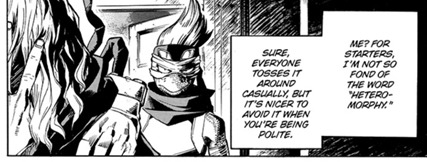
We’ll go with the official version this time.
So here we have the observation that the word absolutely everyone uses, the word that, as far as we know, academically defines an entire category of quirks, is an unpleasant, even rude word. But what is the alternative? We’re never given one. Indeed, Spinner doesn’t suggest one; he says that the nice thing to do is “avoid” the word instead. In other words, talk around it. See again what I said at the start about all the difficulties baked into that prospect.
Later, we get the first drops of Spinner’s backstory, and hit again on the “lizard” thing, with the note that Spinner’s backwater, stuck-in-the-last-century hometown called him “the lizard freak.” He grew up with it, grew accustomed to it, thought there was nothing he could do to change it—he might even have internalized it somewhat, though clearly by the time Chapter 160 rolled around he was ornery enough about it to complain.
It's perhaps also notable that Spinner knows who the CRC are. Though we’ll later find out that their numbers have hugely diminished, he not only recognizes them, he’s not even surprised to see them—unlike many, Spinner knows the CRC never truly went away. (Compare his lack of reaction to, for example, Shouji's unsuspecting classmates, who will later be shocked, just shocked, that this kind of ugliness still exists in their country.)
So just to state the obvious here, yes, the presence of active hate groups does irrevocably shift the lens on everything we’ve seen up to this point. You can’t say calling a heteromorph an animal is harmless, a little insensitive at worst, maybe even meant as a cute nickname, when that same language is used by openly violent bigots.
The volume version gives us, at the end of the chapter, further notes on the CRC. It’s full of relevant tidbits, so I’ll provide the text in its entirety:
Once superpowered society grew more stable and less chaotic, this group emerged, based around a lack of acceptance for those with body-altering quirks. They started out with demonstrations and protests but eventually started committing violent hate crimes. Most felt this was taking things too far, so the group saw a sharp decline in membership and a scattering of factions. These days, one faction might only reject people with animal properties, while another focuses its hate on people with irregular heads. These two, among others, have very few members left. The faction that Tomura and the villains attacked was one that stood by the original group's fundamental tenets.
So what is there to gather from this? Let’s break it down a point at a time.
“Once superpowered society grew more stable (...)”
If you’ve ever lived through a time of increasing acceptance for a marginalized group, particularly if that acceptance involves measures for legal protections being passed, you’ll recognize what this is. Just to pick a few U.S. examples, the KKK didn’t exist until after the Civil War;[4] proactive federal bans on same-sex marriages didn’t start getting passed/proposed until individual U.S. states started legalizing them and civil unions. When opposition to something is the norm, said opposition often doesn’t start organizing until they see that status quo being threatened; they weren’t organized before because they never imagined they’d need to be! That’s what we see with the CRC: they didn’t formally declare themselves until it started looking like quirks—and especially non-baseline quirks—were going to find legal acceptance.
[4] Literally. The last day of the war was May 26, 1865; the date the first Klan was founded was December 24 of the same year. Easily the most vile thing I learned in the process of writing this piece.
“(…) based around a lack of acceptance for those with body-altering quirks.”
This is what I was referring to when I said Spinner's characterization of the CRC might be a little bit off: the CRC wasn’t founded because of a hatred for specifically heteromorphic quirks; they were founded because of a hatred for different bodies, a descriptor that could also apply to those with transformation-style quirks! Those, too, are quirks that alter bodies, after all; it’s just possible for people to turn them off, which is not the case for those with heteromorphic quirks. So Spinner was not quite on the mark before.
Further, note that the phrase “body-altering quirks” is used here—a phrase that’s similar in meaning and much less othering than igyou. It doesn’t fully cover everything I use “heteromorphic” and “non-baseline” to cover, in that it’s still murky in situations like e.g. Cementoss’s, where his emitter quirk is entirely independent of his oddly shaped head, but it’s still a useful term! Except for the small complication of where it isn’t found: anywhere in the actual story. The fact that Horikoshi uses it in an author’s note, but it comes up nowhere in BNHA proper, puts it in an unclear place as far as in-universe alternatives go. Has it just not come up because Horikoshi hasn’t thought to include it? Or has it not come up because it’s not a phrase people in-universe use?
“They started out with demonstrations and protests but eventually started committing violent hate crimes. Most felt this was taking things too far, so the group saw a sharp decline in membership and a scattering of factions.”
Confirmation here of what Spinner said about the CRC and hate crimes, but note what this doesn’t say: that the CRC was outlawed. There are, I suspect, a couple of factors influencing that.
o Firstly, while Japan has legal methods to restrict undesirable organizations,[5] making it difficult for them to raise funds or engage in publicity, the country doesn’t actually de facto criminalize membership in such organizations. That distinction is part of the legacy of violent crackdowns on labor groups and protest movements in the first half of the 20th century; people tend to get very loud about anything that whiffs of the government trying to give itself the power to get that heavy-handed again.
Assuming that the laws haven’t changed overmuch in HeroAca!Japan, then, I wouldn’t expect membership in the CRC to have been criminalized outright, but the volume extra doesn’t mention any kind of legal repercussions at all. That, I think, may go more to my next point.
[5] The relevant laws are aimed mostly at terroristic groups or organized crime.
o Secondly, another thing Japan has very, very little of is hate crime legislation. From my research, there are only two laws of any note: a federal law passed in 2016 and widely regarded as toothless thanks to it lacking any criminal provisions targeting offenders,[6] as well as a local ordinance passed in Kawasaki in 2019 that went as far as mandating fines against repeat offenders, among other measures.[7]
[6] It required the government to start “implementing measures” to eliminate such speech/behaviors, as well as to “respond to requests for consultation” from victims, but did not directly mandate consequences for offenders.
[7] I suspect from some of what I read that Osaka has picked up a similar ordinance, but I didn’t find anything detailing it specifically. Osaka and Kawasaki are home to the largest and second-largest population of Koreans living in Japan.
One major thing neither of these measures did, though—and something activists have been pressing for—is to establish standards for considering discriminatory motivations when issuing sentences against those who have committed violent crimes. To pick an example that made the news last year, a man committed arson out of openly admitted hatred for the Koreans he targeted, but nowhere in the trial or discussion of his sentence did the prosecution ever bring up discrimination.[8]
[8] https://mainichi.jp/english/articles/20220829/p2a/00m/0na/015000c
Also, it’s worth noting that both of these measures were aimed at ethnic discrimination—speech and behavior targeting people living in Japan while being themselves, or being children of, people of non-Japanese ethnicities. They did not address discrimination based on e.g. religion or sexuality.
Folding both of those points together, the image we have of the CRC is of a violent hate group whose existence is regarded as perhaps distasteful and extremist, but not actually illegal. Even what few laws Japan has now wouldn’t have applied to anti-heteromorph discrimination, because, while they may look wildly different from a prototypical Japanese person, heteromorphs still are Japanese, and therefore not protected by a law based solely around ethnic discrimination.
Incidentally, the ordinance in Kawasaki laid out a number of specific examples of the kind of behavior it was looking to address, and one of those examples was likening victims to something other than human. I know why that was included in the context of anti-Korean sentiments,[9] but it certainly does shade e.g. Dabi calling Spinner a lizard more harshly to know that there’s legal precedent for categorizing such dehumanizing language as hate speech.
[9] An extremely common form of anti-Korean hate speech in Japan is to refer/allude to Koreans as cockroaches.
“These days, one faction might only reject people with animal properties, while another focuses its hate on people with irregular heads.”
This is a good echo of the sort of factionalization you see in organized religion, wherein the minutiae of tenets that seem similar to an outside eye are the topic of vicious, vehement inter-group debate. More to the point, however, it provides an excellent illustration of the senselessness of bigotry. They can’t even keep their own discriminatory dogma straight!
Probably the second most common complaint about the story’s use of heteromorphobia—after calling it retconned-in bullshit that didn’t exist until Chapter 220—is that it’s illogical, that it makes no sense to judge people because they look a little different in a world where everyone is now a little different from the way we see the world.
And I wonder if the people who say that are listening to what they’re saying. “Illogical bias that has no foundation in reality is unrealistic?” What do these people think bigotry is? Racism, sexism, xenophobia, ableism, religious discrimination, all the many different shades of queerphobia: all of these are built on foundations of fear and hate for people who are fundamentally still as human as anyone else, yet they all exist, and have existed, and will go on existing for quite some many years still. Because irrational hatreds are, by definition, irrational. Heteromorphic discrimination is the most realistic societal dynamic in the entire series!
That little rant aside, I also want to highlight the first group in the excerpt above—people with animal properties. Check any talk on the theme of, “So you can believe dragons but not black people in fantasy?” and you’ll run into the ways people are much more ready to suspend their disbelief for full-on fantasy than for something that, rightly or wrongly, pings them as incorrect, and it’s easy to imagine animal-associated heteromorphs running into a similar issue: it’s fine for people to just look weird, but looking like an animal, that’s bad and unnatural. A heteromorph who just looks like nothing in particular other than “non-baseline” is not evoking the baggage of animal anthropomorphization and cultural animal symbolism that someone who looks like a bird, a lizard, a dog, an orca, etc. is.
Chapter 223:
Shigaraki refers to Gigantomachia as a gorilla. It’s debatable how much this is of a piece with Dabi calling Spinner “Lizard”—Machia’s only actual animal quirk is Mole, not anything simian, nor is Machia particularly ape-like in anything other than his large size—but it does stand out to me that Spinner, who we know to have strong opinions about animal epithets, just refers to Machia by name or as “the big guy.”
Chapter 224:
Mr. Compress calls Machia “our pet gorilla”; see note above.
Chapter 226:
Curious introduces the idea of quirk counselling, telling us that its goal is to align people to a unified understanding of how the world and society work, but that it’s flawed in that it winds up emphasizing peoples’ differences instead. The advisor at the hospital raid will include quirk counseling in his litany of grievances, so I’ll discuss its possible utilization against heteromorphs more there, but for now, recall that I talked previously about how quirk-based behavioral tics might vary from person to person by comparing Hound Dog with Sansa. With that in mind, it’s not a big reach that some heteromorphs might run into similar problems with quirk counselling.
There are a good number of what appear to be heteromorphs through the Curious fight; whatever the MLA’s core views on quirk supremacy, the organization self-evidently makes ample room for heteromorphs, even if, like e.g. the red panda guy in the crowd jumping Toga inside the noodle joint, they don’t seem to have any other stand-out powers beyond the fur and fangs.
Chapter 229:
Twice notes in his flashback that something about his eyes always rubbed people the wrong way, scared them. We’ll eventually see this same thing with Tenko on the street—a totally normal-looking child, but the look on his face scares people away even more than the blood. And I can’t help but think, “If even a totally baseline person’s eyes can creep people out, how much easier—and more extreme—is that reaction for the more out-there sort of heteromorph?”
Gori makes the tiniest of cameos in Twice’s flashback, playing backup off to the side when we will, in current times, find him having worked his way up to the interrogation chair himself.
Chapter 230:
Geten brings us quirk supremacy via his understanding of the MLA’s goals. It’s hard to say how accurate this is, since the MLA leadership is inconsistent on what exactly their vision of Liberation entails. Whatever it is, it certainly doesn’t seem to dissuade the MLA’s own heteromorphs, though of course there’s a big difference between how e.g. Spinner or Ojiro versus Gang Orca or Mirko would fare in a societal quirk free-for-all. Likewise, the MLA is a cult, so one can’t discount the likelihood of double-think in its members.
Chapter 232:
Re-Destro talks about the state of the country in Destro’s infancy, a period in which metahumans suffered “constant abuse—blatant discrimination.” Merely for speaking out that her child was just like everyone else—that his special power was just a quirk—Destro’s mother was killed by an anti-meta mob. This gives us further evidence of the violence metahumans faced. Of course, in that time, the hate wasn’t distinguishing between types of quirk, but with that being said, an emitter and a transformer can still hide the truth about themselves with far more ease than heteromorphs—recall All Might’s discussion about the early days of quirks back in Chapter 59, in which the panel showing four people with quirks contained only one baseline person. It would be entirely unsurprising for an outsized number of the metahumans killed in those days to be heteromorphs.
Chapter 233:
The confrontation between Trumpet and Spinner gives us Trumpet clucking about Spinner having a weak meta-ability—Gecko lets him cling to walls, and that’s about it. It’s a striking contrast to someone like Mirko or Gang Orca, or even Tsuyu, all of whom have some combination of big power moves and a veritable fleet of sub-abilities. We can see the way Hero Society prizes powerful, flexible quirks in this. Having a strong quirk can help overcome the societal bias about heteromorphs, but if you’re stuck with a weak quirk and a weird face, you lack that metaphorical ticket out.[10]
[10] Incidentally, the fandom reflected some of that attitude as well. There was a widespread assumption that Spinner’s quirk would be really useful or situationally powerful, otherwise why would Horikoshi have hidden it for as long as he did? Then, after the reveal, there was a certain amount of complaining that Spinner was useless to the League, and why even bother with him? Sometimes, life imitates art in some very unflattering ways.
Trumpet brings up that Spinner was a recluse, “mocked and pilloried,” and we see Spinner in his hikikomori days. What we’ve gotten on Spinner up to this point suggests that the abuse he endured was mostly verbal, though one can imagine it was pretty rough when he was young enough to be the target of school bullies. There’s a certain amount of temptation to minimize that in comparison to his response: most people who are bullied or targeted by discrimination don’t grow up to become terrorists. But there was, we will eventually find, more visceral stuff going on—and parts of the country that were even worse than Spinner’s hometown.
Spinner spent most of his life trying to fit himself into the world around him; his strongest parallel in the League
in this regard is Toga, as they were the two that held themselves back, let the world define what they were and how they should act, right up until they saw something that caused them to snap.[11] Trumpet tries to do much the same to Spinner here (albeit probably less as an intentional psychological attack than Skeptic’s attempts on Twice), but Spinner, like Toga, is long past the point where he would swallow that abuse without fighting back. When you tell someone they are something long enough, they eventually start to believe it—but if you aren’t careful, they’ll start to embrace it, at which point those weaponized words change hands.
[11] Shigaraki and Dabi, by contrast, pushed back harder, trying to get the world to accept them and never accepting it when their families (and particularly their fathers) told them to stop. Twice was ejected without getting the chance to try to contort himself into a shape that fit the world, whereas Mr. Compress seems to have been raised to reject his society's accepted norms from the start.
Chapter 234:
We see an image excerpted from Quirks and Us, a children’s book published by Curious’s outfit, that exhorts the reader not to judge people by their quirks. It really, really begs the question, “If this is what’s being said in literature published to coax people towards anti-suppression radicalism, what on Earth is normal society saying?”
Regardless of that absolutely wild disparity, though, the fact that there are children’s books being published about quirk bias being wrong suggests that the world very much does have a problem with quirk bias. Indeed, that much has been shown throughout the series, not merely in terms of anti-heteromorph bias, but also the bias against “villain quirks,” as well as the widespread idea that people with weak quirks—or no quirks at all—are weaker people overall, pitiable folk who lack the power to live their fullest lives or pursue their dreams unhindered.[12]
People on more than one of these axes of discrimination will, as in real life, be more likely to experience discrimination and violence.
[12] Villains like All For One and Geten may say it more loudly, but it’s not only villains who believe it—perfectly good-hearted people like All Might and Midoriya Inko fall into that trap as well.
Chapter 237:
Nothing much to say about Shigaraki’s flashbacks save to note that, if people won’t stop to help a lost and bloodied (and baseline) child, they sure as hell won’t intervene in anti-heteromorph bullying. Recall that Kirishima was accused of sticking his nose where it didn’t belong for trying!
-----
Thanks as ever for reading along, everyone! How was the new footnote format? Should I keep that up for lengthy meta going forward?
I was kind of expecting to be able to wrap this up (the main canon, at least) in one more post, but I underestimated the amount of writing I'd be doing for the first war arc. For next time, then, I'm looking to cover the Endeavor Agency, Paranormal Liberation War, and Dark Hero Villain Hunt arcs. See you all then!
#bnha#heteromorph discrimination plot#bnha worldbuilding#bnha meta#my writing#creature rejection clan#tw racism#tw hate crime#bnha spinner#iguchi shuuichi#meta liberation army
83 notes
·
View notes
Photo

My Hero Academia, Chapter 370 Thoughts.
Admittedly, I was very confused by Shoji’s response to the PLF members legitimate complaints about the discriminations that heteromorphs have suffered with a question that is off topic and tone deaf at the best, and deliberately undermining the legitimate suffering that heteromorphs have endured at the worst.
But let’s give Shoji the benefit of the doubt as we discuss his argument and point of view underneath the cut.
However, Shoji’s response reminded me of one of my favorite posts observations made by another tumblr user. @yugiohz on this panel featuring Shigaraki and Deku from the war arc.

“I love this paneling because it shows the contrast of the character’s world view, deku thinks this conflict only happens on a personal level when shigarki is aware that it’s a systemic one.”
Shoji’s arguments seem arguably tone deaf and oblivious to both the bigger picture that the PLF commander is getting at. The existence of entities like the creature rejection clan, and the atrocities committed against heteromorphs which is apparently, still so prevelant an issue that fifteen thousand people showed up to the riots. So this issue is not only still relevant, but wide affecting.

So to respond to all of those legitimate questions with the question of why didn’t thiey think of evacuating the hospital first like the heroes did, and the implication that if they didn’t, they are just as bad as the people they are protesting against is just a little bit ignorant. Or maybe a lot of bit.
In all fairness, of course even in a war it’s considered a crime a target full of innocent people uninvolved with the conflict as a part of your battle strategy. From Shoji’s perspective, these people are attacking a hospital full of sick people unable to defend themselves which are unrelated to their grievances against society at large. Even in war times it’s considered taboo to attack people who didn’t sign up for the conflict and are also unable to defend themselves, civilians, sick people, the wounded, children.
t’s fair to point out that it’s wrong to target people who aren’t combatants who signed up for the fight, but at the same time if you point that out it’s also fair to point out it’s the heroes who decided to shelter Kurogiri in the first place. The mob isn’t attacking the hospital of a whim, they’re trying to seize an objective to win a battle against the society they think wronged them, and the heroes are the one who decided in the first place to hide Kurogiri in a hospital full of innocent civliians. It’s the heroes who knew that this hospital would be attacked hence why they posted guards there, but apparently didn’t evaucate the hospital. So, if we’re splitting hairs here, the split hairs still don’t come out in favor of the heroes.
However, as tone deaf as Shoji’s question comes across, it also resembles a lot of responses his fellow hero students have had whenever they’re face to face with the villains trying to explain how they’ve suffered against hero society.
When Toga tries to explain herself to Uraraka she’s immediately shut down with this argument. That if she chooses to live as she pleases and threatens with people, then there’s also consequences to that.
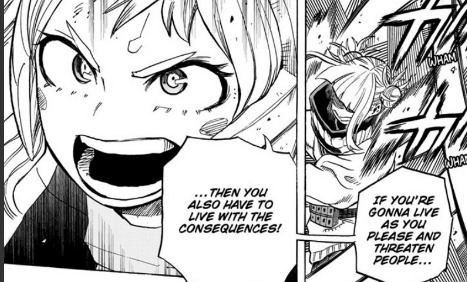
As referenced above, when Deku says that he won’t ever forgive Shigaraki, Shigaraki replies with I won’t forgive any of you people. When Dabi tells Shoto about how he tried to come home, but in the end was shown that his family just moved on without him and that he had no replace to return to Shoto responded with this.

It’s three flavors of the same response. It frames Toya, Toga, Shigaraki, and Spinner + the Mob’s Choices as a whole like they woke up and one day decided to be a villain.
LIke, do Toga and the rest have agency and responsibility to their actions? Yes. THey chose to become violent. They chose to fight. They are still people making choices no matter how driven by their own trauma and they are responsible for those choices. However, there’s a difference between an influenced choice, and a choice made entirely of their own free will.
Here, let me demonstrate. Absoluetly nothing forced Enji to abuse his own family. Enji decided on his own to place his career as a hero above everything else, he decided to arrange a marriage with Rei for the entire purpose of giving birth to a child with a hybrid ice and fire quirk and also ignore his children who didn’t suit that need.
However, Toya had no agency in this choice. He was born into these circumstances. Through no choice of his own, he was born to a father who ignored him the moment his quirk started failing, and a mother who blamed him for the discord of his household for not simply giving up on his quirk training and his attempts to earn his fathers love because she was too afraid to conront her husband. Toya was a helpless child when this happened to him, he’s a fully grown adult now, but when the inciting incident of his trauma happened to him he was as those innocent as those imaginary innocent people that heroes keep parading about as a reason tto not sympathize with the villains.


Rei had no choice but to marry Enji because her parents pressured her into it, she became a victim of his abuse, but you know who was even more of a victim? The twelve year old helpless child who was born into these circumstances, who was also completely defenseless at the time. Who’s father ignored him, and mother wasn’t strong enough to protect him, whatever Rei suffered, Toya suffered more and at a much younger age.
Basically every argument the villains make is dismissed with “cool motive, still murder”, which is a completely ignorant argument to make when these villains only started choosing violence as an absolute last resort in the first place. Toga did her absolute best to fit despite her parent’s abuse. Toya tried over and over again to please his father, only to be told to shut up by his family. Tenko wanted to be a hero originally, and was beaten by his father, for having the same dream as Deku. Tenko spent days wandering the streets waiting for just one hero to help him after he lost his family. Spinner locked himself up in his room and just wanted to believe he could become someone important like Stain and make a positive change in the world rather than wasting his life.
These arguments are in bad faith, because they’re taking a false equivalence. The villains arguments about how hero society is wrong, because they too, are hurting people in their attempts to change hero society. The thing is twice already completely dismantled the argument that the heroes use to shut down the villains.

The heroes only care about saving the kind of completely innocent victim who cowers in the face of danger and waits to be saved, if they think of fighting back against their circumstances, or *gasp* lash out in pain like some kind of imperfect victim then the heroes give up on trying to save them. It’s important that Jin brings up Toga’s kindness to him, because Toga is one of the people that Hawks wrote off as someone who can’t be saved, while at the same time trying to save Twice because he considered him “A good person.”
The thing is the moment you start dividing people into categories of who is worthy of being saved, and who isn’t, people are already going to be lost. If the function of heroes are to save people, and they’re not saving a goood chunk of people then they’re not doing their job. Rather than addressing this fact and striving to say more, they just create arguments that are these false equivolencies. Well, this person chose to become violent, so obviously they’re just as bad as their abusers. Well, Dabi chose to kill people in his attempt to discredit Endeavor and expose him as an abuser, so obviously he’s just as bad or even worse.
There’s a difference betweeen saying “I understand your argument but I believe there are better more peaceful ways of solving this issue” and just shutting down the argument, which is what the hero kids are doing over and over again. And this is a common theme in MHA. THat the light of heroes, and the flawless image of heroes is being used over and over again to hide the corruption in society. Nagant brings it up, Shigaraki brings it up, that over and over again the public only sees the good side of heroes while the corruption of society is ignored.
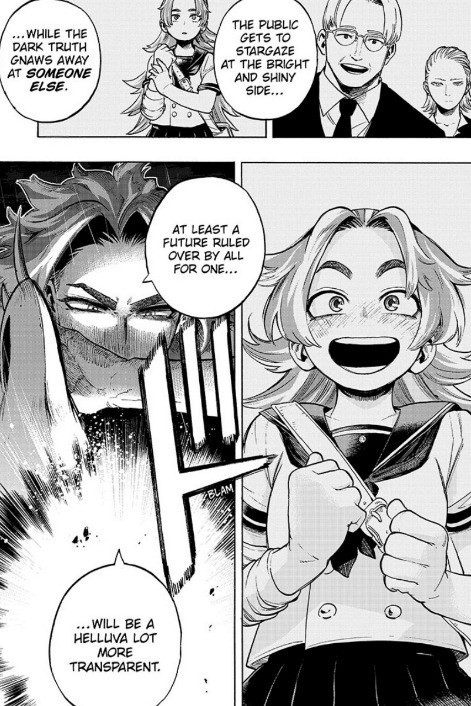
Yes, it’s bad to hurt innocent people even if you’re trying to use your violence for a good cause to make a better world. People who have nothing to do with it don’t deserve to get dragged into a conflict. However, there’s also this continued pattern of heroes just dismissing the legitimate criticisms of villains outright, because of the faceless imaginary people that are also being caught up in their rebellion against society.
This is why Hawks killed Twice. Hawks had to kill Twice, because of the imaginary body count of innocent people who might have been hurt with his quirk. The heroes continually have to put down the heroes in favor of there imaginary innocent people that they might be hurting, Uraraka even says that she has to look at the destruction wrought by the league of villains to stop herself from sympathizing with Toga.

But once again, this innocent / guilty dichotomy is a made up false dichotomy. When exactly does a person stop being innocent? What actions do they have to perform where they are no longer worthy of sympathy? Quantify it. What is the point of no return? At what exact moment do they stop being a victim and become a villain instead?
Think of the people who joined Spinner’s mob in support of Heteromorph discrimmination? They were innocent victims of what is a thinly veiled allegory for racism. They did absolutely nothing to earn the ire of the people around them. Are they now guilty because they decided to fight back against it? Is their action to riot against the issue, to try to draw attention to their suffering what makes them now guilty? Is the only way to remain innocent to just shut up and endure it, and never fight back no matter what happens to you?
To return to the argument made at the start, it really does seem like that kids are equating what is a personal conflict with what is happening on a societal wide scale. The perspective of the hero kids is almost like, even in the middle of what is called the first and second war arc, where they are fighting a battle over the way society should be run, that somehow this is just standard hero vs. villain in the conflict. That the good guys are infallible and the bad guys are always violent and they are because they decide to be. However, the villains are fighting back against a society that has wronged them. It’s a difference in perspective that damns any attempts for heroes and villains to understand each other.
The kids aren’t facing the injustice of society, the kids aren’t fighting for survival, for them this is another hero vs. villain battle. They defeat the bad guys, and the good guys win.
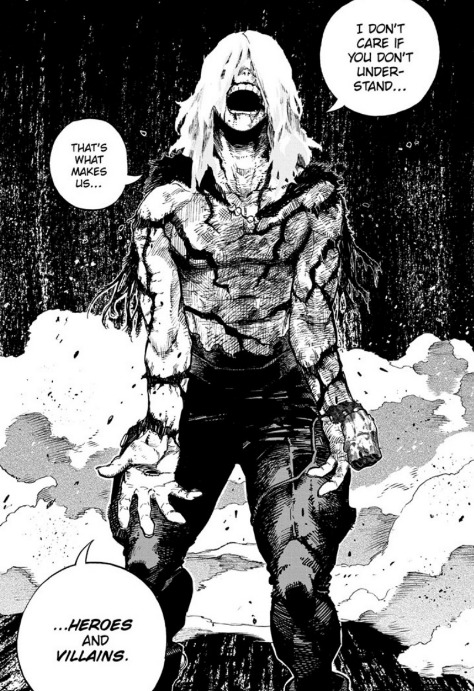
It’s a conflict fought between two sides who are occupying completely differnt positions of power and privileges'. It’s a personal conflict for the kids, they are fighting against villains who have personally hurt them and all of their friends, SHigaraki is someone who maimed Grant Torino in front of Deku, and led attacks on his friends several times. However, at the same time Shigaraki was wronged by hero society several times, an argument that Deku pretty conveniently ignores because he’s never lived that experience or been subjected to it. He’s allowed to keep it a personal conflict, because he’s not subject to societal rejection the way Shigaraki is.
Even if the kids think that human life is so sacred that no matter what you can’t take a life, even if you have a legitimate cause like fighting for a better society, the kids refuse to apply their rules fairly. Shoji yells at the crowd for attacking a hospital full of innocents, but what about the death of Twice? If villains are bad and beyond redemption because they have killed, then why is Hawks still allowed to be a hero? If the villains have to think about the people they hurt as a part of their conflict, then why hasn’t a single hero kid even mentioned twice?
This is what I mean by injustice. It’s okay to be disgusted by murder, human life is sacred and should always be protected, murder is a serious crime, but these rules aren’t being applied fairly. Hawks can commit the same murder and compeltely get away with it, because he’s considered one of the good guys.
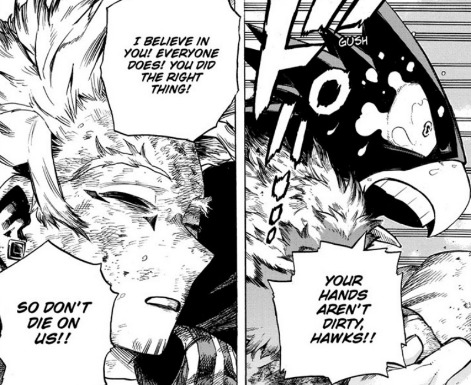
The kids aren’t so digusted by any murder that they can’t tolerate any injustice, they’re just repeated the same values that they’ve always been taught, heroes good and villains bad. They are drawing the same line on who is worthy of saving and who is not worthy.
Which is why this chapter is so sad, it illsutrates that Shoji and Spinner have suffered the same way as being prejdugiced against by hero society, and forced to hide because they are heteromorphs. So, why are they fighting in the first place? If they are both vicrtimized why does one of them have to be the good cictim and the bad victim? If they are both suffering similarily can’t they come to some understanding and work together, rather than fighting against each other? Isn’t it tremednously sad that Shoji had to fight against several heteromorphs who have suffered the same as he as, and defend the society that has outcast him and fored him to wear a mask his entire. Shouldn’t there be a better way then just Shoji putting down the rebellion of fellow heteormoprhs and then society continuing on the same way as it always has? Couldn’t they work together?
I don’t really have an ending to this post, so I’m going to close out with a quote from Frankenstein which I believe is relevant to this topic at large.
“You, who call Frankenstein your friend, seem to have a knowledge of my crimes and his misfortunes. But in the detail which he gave you of them he could not sum up the hours and months of misery which I endured wasting in impotent passions. For while I destroyed his hopes, I did not satisfy my own desires. They were for ever ardent and craving; still I desired love and fellowship, and I was still spurned. Was there no injustice in this? Am I to be thought the only criminal, when all humankind sinned against me? Why do you not hate Felix, who drove his friend from his door with contumely? Why do you not execrate the rustic who sought to destroy the saviour of his child? Nay, these are virtuous and immaculate beings! I, the miserable and the abandoned, am an abortion, to be spurned at, and kicked, and trampled on. Even now my blood boils at the recollection of this injustice.”
#mha meta#mha 370 spoilers#bnha 370 spoilers#bnha spoilers#mha spoilers#mha 370#bnha 370#spinner#shuichi iguchi#mezou shouji#mezo shoji#plf#heteromorph discrimmination#plf meta#mla meta
412 notes
·
View notes
Text
Felt like sharing some speculation today:
All right, so we know My Hero Academia has the something of the same premise as X-Men in the sense that select a group of humans were suddenly born with powers, the whole 'evolution leaps forward’ deal.
We see in My Hero how the First Generation of people with Quirks, especially the ones who appeared non-human or semi non-human, were originally ostracized like the mutants of X-Men are, but then more people were born with powers and then more people had powers until it became a widespread phenomenon and ‘normal’ people became the minority and society had to restructure itself to accommodate the new normal.

But have you read The Resurrectionist: The Lost Work of Dr. Spencer Black?
The plot is a 19th century doctor who theorizes that mythical creatures like the minotaur, harpies, sirens, and the like all existed millions of years ago but slowly interbred with humanity and eventually died out altogether. So he believed that when someone was born with extra fingers, limbs, a tail or otherwise didn’t have the typical human shape, it wasn’t so much a mistake in genetic coding as it was the extremely recessive genetics of those ancient creatures trying to reoccur in the modern day.
...
Definitely an interesting premise, so now I’m wondering if the My Hero world has a cult, conspiracy theorists, or even some scientists/historians that have similar views regarding mythology.
If this whole Quirk thing happened back in the Stone Age where no one had the benefit of science or awareness of DNA, anyone born with an otherworldly power would have been worshipped as a deity. Or the ones born with a non-human appearance would have been reviled as monsters.
So following the idea of The Resurrectionist, maybe the sudden appearance of superpowers did lead people to take a closer look at the old myths and consider the stories of the gods/goddesses of old were originally stories of people with 'Quirks' who rose to power. Humans with meta-powers ruled the world for a few centuries, then those powers inexplicably died off. For a variety of reasons or maybe unknown reasons, humanity lost that history but remembered the old stories and chalked them up to just myth until the powers that made it possible began to reappear full force several millennia later.
Some myths began as historical events but in being handed down hundreds of generations, the multiple tellings and retellings exaggerated them into the realm of impossibility.
Lightning/electricity powers: Zeus, Thor, Hinon
Fire powers: Hephaistos, Surtr, Hestia, the phoenix
Foresight: Any seer, prophet, or oracle that appears in any myth ever
Ice powers: Yuki-onna, Skadi, Morana
Water powers: Poseidon, Chalchiuhtlicue, Anuket, Tlaloc
Plant-related Quirks: Demeter
Gigantification Quirks: Giants, titans, nephilim
Ryukyu: Is a dragon. ‘nuff said.
All Might: Herakles
Tokoyami having a bird head but otherwise appearing human is pretty reminiscent of the old Egyptian gods.
Hawks: Any winged creature; take your pick. Personally, the one that comes to mind for me is Hermes. He only had wings on his sandals, sure, but the trickster archetype resonates.
Tsuyu: Naiads, nymphs, rusalki, any kind of water fae
Momo: Sedna (created sea life from her finger bones), Ukemochi no Kami (produces food from her own body)
Best Jeanist: This one's a bit of a reach, but the fabric thread thing coupled with the long, spider-like limbs kinda brings to mind the story of Arachne the weaver.
We do get a nod to Ancient Greek mythology with the prison Tartarus. What better place to lock away beings with god-like powers than the prison of the Titans itself?
Obviously an incomplete list, but you see my point.
Personally, I'm leaning toward cultist ideology with this one as I find it hard to believe every civilization would have forgotten about a previous appearance of Quirks. But civilizations die off, civilizations are overrun by others and their histories are suppressed, maybe this hypothetical 'previous Quirk phenomenon' wasn't as widespread as the current one and so fewer people were affected and therefore fewer people were alive to verify the truth of facts, maybe this hypothetical time was from an age of oral history and nothing was documented properly, so not impossible just really, really improbable.
Still, I love mythology and I find it an interesting headcanon to think about.
#my hero academia#the resurrectionist#hawks#fumikage tokoyami#keigo takami#ryukyu#mythology#folklore#bnha#mha#boku no hero academia#headcanons#quirks#all might#yagi toshinori#tsuyu asui#momo yaoyorozu#denki kaminari#tartarus#best jeanist#dabi#endeavor#shouto todoroki#heteromorphs
21 notes
·
View notes
Text

(Source)
20 notes
·
View notes
Text
Reminder: animals only have sex, not gender
#And those sexes do not often align with human sex characteristics#Birds don't even have xy chromosomes. Their ones are zw#And the males are the heteromorphic ones#And birds have similar bimodal distribution between the sexes! Don't even think about fungi sex.#The idea that sex is this easy simple thing completely stumps me. Are we living in the same world#Also gender is made up. This isn't me shaming you for giving your dog pronouns because she has a vagina#But you have to bear it in mind when talking about animals. They have no gender. They only have sex and sex characteristics#Also since gender is a construct it means humans can do whatever they want forever
26 notes
·
View notes
Note
there are fans still going after shoto’s mutt comment ughh i resent that shoved in mutant “arc”. here’s the truth, it was badly written on both the hero and villain side! i saw a take where spinner should’ve been a quirkless regular looking dude and i think that would have fit his concerns and connection to shigaraki much better.
If Shouto's mutt comment was meant to be part of the mutant plot, I think we would have seen a follow-up. I think the fact that we see Shouto hang out and interact with Shoji and Tokoyami quite a bit and neither of them have any comments about Shouto being possibly bigoted in the flashback makes it clear that the mutt comment was there to characterize Shouto's rebellious streak vs authority figures and his "relatively ill-mannered" mouth. Also, just the fact that he feels passionately about the subject of rigid and ridiculous rules that lose sight of heroism.
If Shouto was meant to demonstrate some anti-mutant sentiment, I don't think Horikoshi would have shown Shoji react to Shouto's win this way:

That was merely a few chapters before the mutant plot, and if HK wanted to, he could have made the flashback about Shouto rather than Mineta making a mean comment. But he didn't - so I think that's really all the proof I need that the mutt-stuff is not in anyway related to the mutant plot.
#c1a asks#todoroki shouto#you will always find malicious takes#heteromorph discrimination#mutant discrimination#shoji mezo
72 notes
·
View notes
Text

13 notes
·
View notes
Text

The extremely depressing thing about this panel is that Shoji is not even assuming people will see his scars and feel bad or horrified or guilty about societal injustice and he wants to prevent those negative feelings; he’s assuming people will wonder if he is vengeful, their first instinct to be afraid and cautious of him, like they're the ones who are going to be the victims, with not one shred of empathy. Shoji has no high opinion of people; he does not believe in their better nature.
If a person sees a kid with scars and think not “dear god, poor child, what happened” but instead “that kid is probably dangerously damaged and I need to protect myself,” there’s just no saving this society.
#Shoji Mezo#heteromorphs#bnha#mha#HeroAca#nalslastworkingbraincell#Chapter 371#Maybe that's why no one bothered to help Tenko during The Walk#Look and be any sort of different and no one will care
259 notes
·
View notes